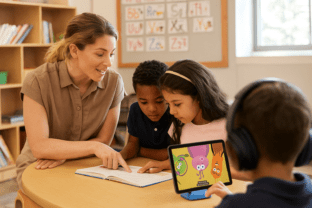The end of the school year means something different for each person in a school setting. Students rejoice that summer is here, while teachers look forward to closing their classrooms and preparing for the fall semester. As a school principal, your closing checklist is a little more complicated than powering down your computer and locking up your office. You might have dozens (or hundreds) of staff members that all need your assistance to wrap up the year. An end of school checklist for principals sure would be nice!
Fortunately, we have your guide to stay organized. Use this checklist to make sure you tie up any loose ends related to your staff, policies, and personal career goals before the year ends.
1. Help Your Teachers End the Year
Your teachers are eager to end the school year, but they also need to meet with you to discuss the fall. One of your biggest challenges as a principal trying to end the year will be setting aside time to meet with each teacher so they can clear out their classrooms. You will be expected to:
- Identify which teachers are returning and which ones aren’t. Offer your goodbyes to teachers who won’t be returning.
- Let returning teachers know when they are expected to return in the fall and if there will be any significant changes to their department or grade.
- Solidify your teacher budgets for the fall. This can help educators get the right supplies, digital tools, and resources they need.
- Provide feedback on teacher performance from the past year. Try to offer action items to educators so they can grow their skill sets over the summer.
- Collect inventory on each classroom with the teacher that runs it. Identify items that need to be repaired or replaced.
If you aren’t careful, you may find that you don’t have as much time as you want to meet with your teachers. Consider setting aside a few hours for each grade over the course of a week (Monday is fifth grade, Tuesday is fourth grade, etc.) to methodically meet with each of your educators on staff.

Image credit: Principal Principles
2. Close Committees and Evaluate Their Efforts
Your staff members invest their time and effort into various school committees, but do these teams actually reach their goals? In the same way that you should meet with teachers at the end of the school year, gather your committees to show your appreciation while evaluating their efforts.
Each committee should have created clear goals at the start of the school year. (If they didn’t, develop worksheets over the summer so committee leads can write down goals next fall.) What goals did the committees achieve? What did they miss?
Use these meetings to evaluate if budgetary changes are needed for certain committees. See which ones need to set more challenging goals next year and which ones need to be more realistic.
3. Take Time to Connect With Students
Many school principals get so caught up in end-of-year administration that they forget to set aside time for students. Your students look up to you as a leader and the end of the school year can be an opportunity to make some learners feel optimistic for the year ahead. A few items to consider include:
- Ask teachers to nominate their most improved students or students who did their best to overcome challenges this year. You can develop an award for these students or invite them to your office for lunch.
- Meet with graduating students to make sure they are ready for the year ahead. Are your rising eighth-graders ready for high school?
- Develop an end-of-year address for students. This can be delivered in person or over the school’s PA system.
- Spend as much time as you can in the hallways during transition times (before and after school, between classes, and during lunch breaks). Calling students by name, giving them high fives, and telling them to have a great summer can create positive associations for the year ahead.
You have an opportunity to make your students remember you and have a positive association with an authority figure – even if the very same students ended up in your office for disciplinary reasons during the year.
4. Reach Out to Parents
In the same way that students can benefit from end-of-year connections with the principal, many parents will also appreciate hearing from you one more time. Develop a communication plan to make sure parents feel confident going into summer and know how to prepare for fall.
- Draft an end-of-year letter for parents that discusses the past few months and prepares returning parents for the coming year.
- Make sure you have a clear center for summer resources. Parents will need access to summer lunch programs, food banks, free summer camps, daycare, summer reading resources, and other support systems. Communicate where parents can find these services.
- Provide information on where parents can find summer reading requirements and school supplies lists for the fall.
- List options for parents who want to avoid summer brain drain. For example, some students may have access to eSpark through the summer to keep adventuring through learning Quests at home.
It’s possible that some of your parents fear you as an authority figure in the same way that students do. By communicating with parents at the end of the year, you can let them know that you are a valuable resource to help their families.
5. Review the Year With District Leaders
As you approach the end of the school year, you may have obligations to fulfill with your district teams. Some district leaders want reports while others request in-person meetings and reviews. Make sure you set aside enough time to meet your district obligations.
Your administrative tasks might be hefty, so try to get a jump on your required reports and paperwork as soon as the requests come in. If you put off these tasks, you could miss out on valuable time spent with teachers and students in order to fulfill your district’s needs.
6. Consider Your Career Goals and Needs
The end of the school year is an important time for you as well. Whether you set concrete goals for yourself or had a mental plan for what the hoped year would bring, reflect on the good and bad of the year. Ask yourself the following:
- What changes do I need to make over the summer to better prepare for the year ahead?
- What crises did I face this year? What processes can I put in place to prevent them?
- Are there any notable wins from the year? What did I do well that I should be proud of?
- Am I happy in this role?
- What needs to happen if the answer is no?
These aren’t easy questions. It may benefit you to solicit feedback from your staff members and district leaders to receive clear feedback on how you can improve. Your role as a principal isn’t just to lead the school. Your job is also to support every staff member and empower them to do the best work possible. Have something to add to the end of school checklist for principals? Contact us using the link below!



